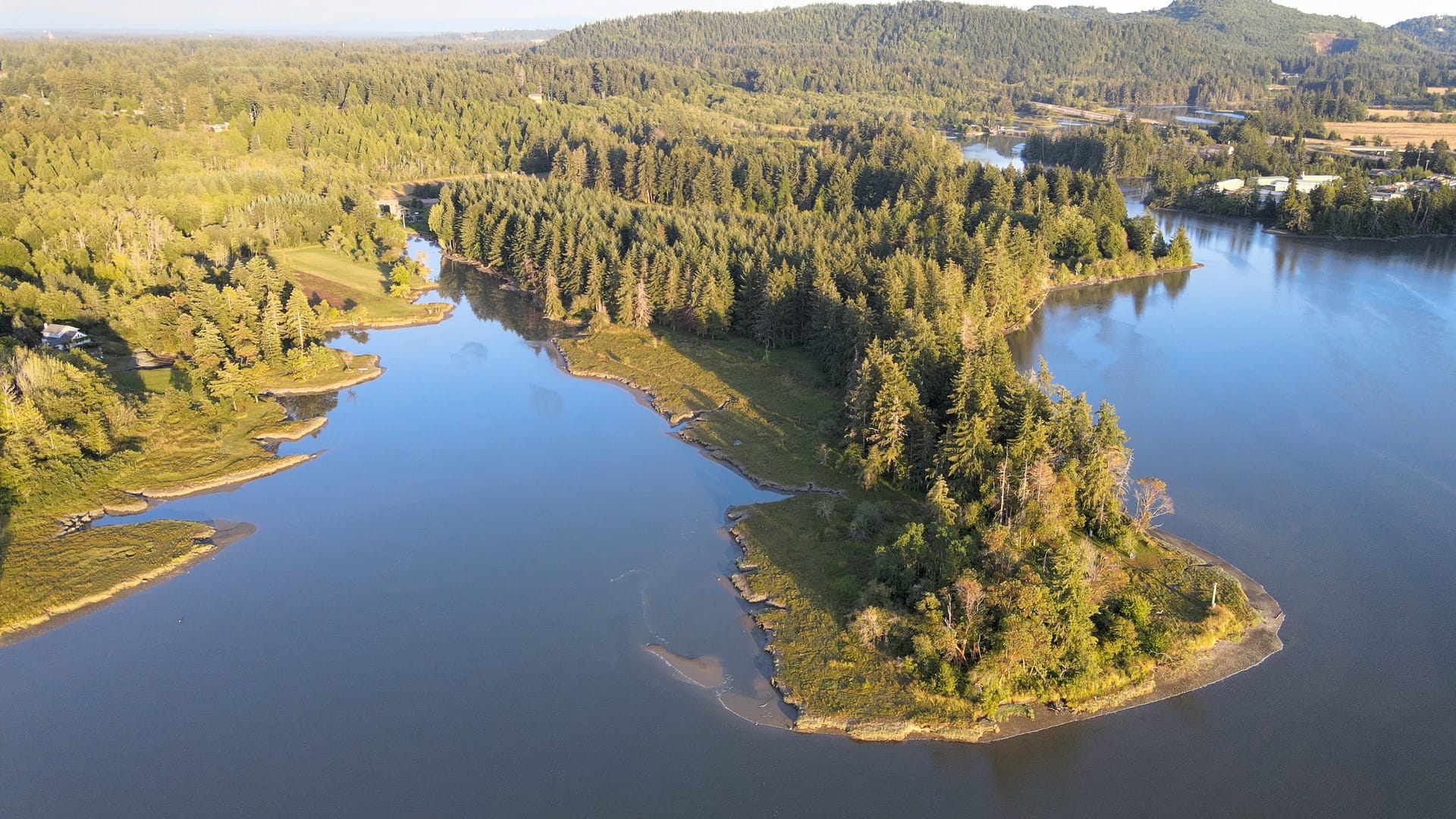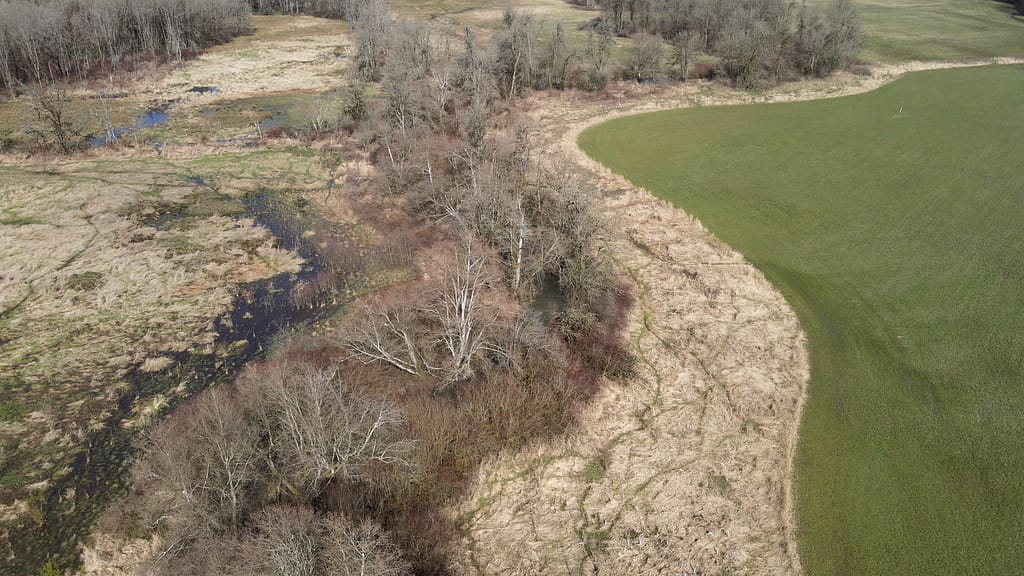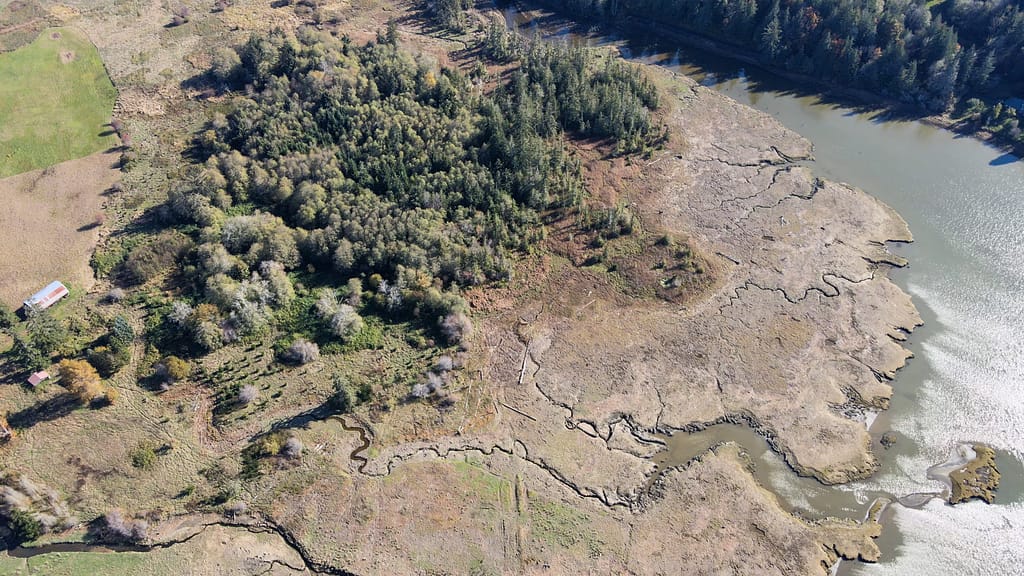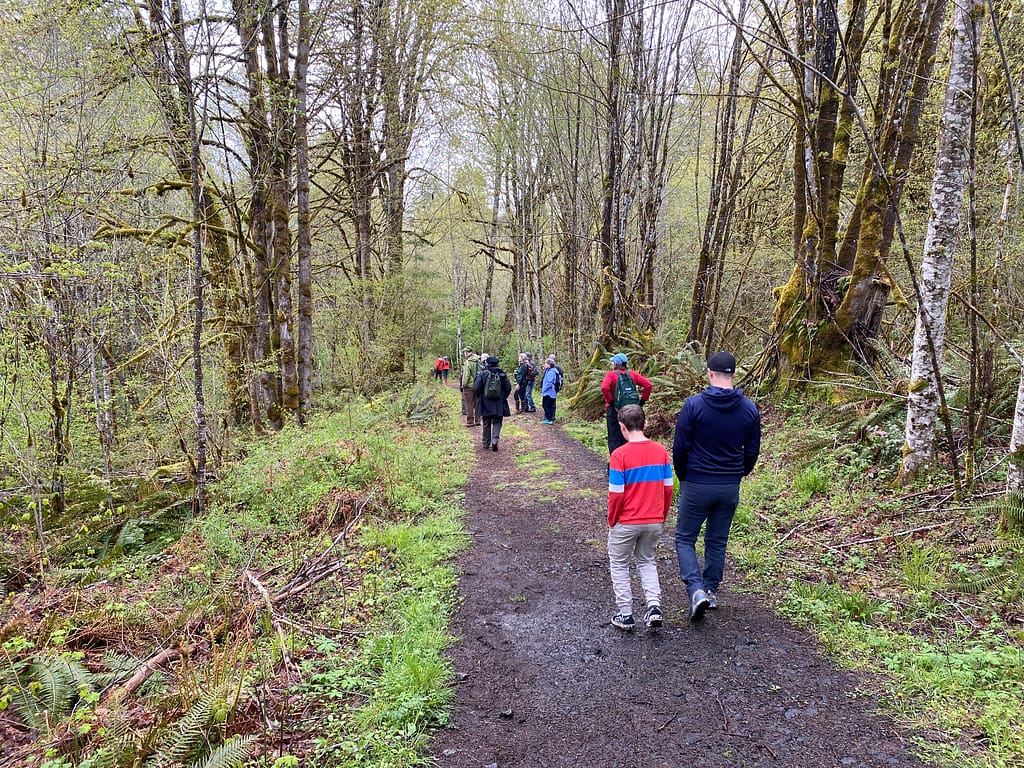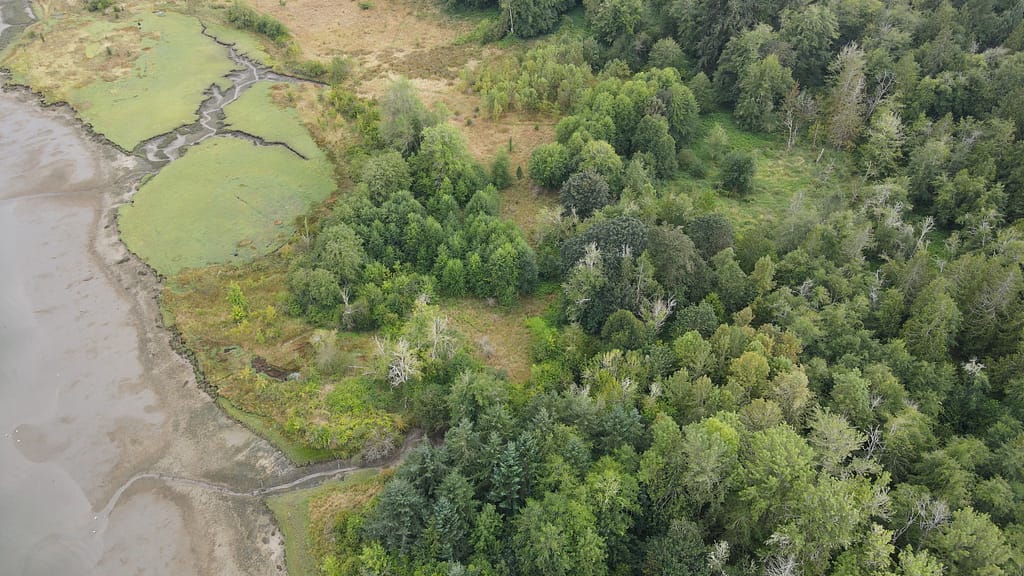A Need, Some Passion, and a Great Idea
Sometimes a movement of monumental and lasting impact begins with a few passionate people. In 1987, a neighborhood’s concern about water quality threats to Henderson Inlet launched an idea: to permanently protect a 68-acre parcel of sensitive creek and estuary habitat at the southern end of the inlet. Through the heartfelt efforts of that small group of people, Woodland Creek Preserve was successfully conserved and remains in conservation today.
The passion of those concerned citizens ignited and tapped into the passion of others. That passion became a mission, and the mission became a 501(c)3 organization with the name Capitol Land Trust (CLT).
- Woodland Creek was the first of many “assists” where CLT played a pivotal role in permanently protecting land for the benefit of the local community. Photo by CLT.
What started as a great idea led that fledgling organization to celebrate its 100th conservation success 37 years later. Combined, these successes have resulted in the permanent conservation of more than 6,600 acres of land and almost 19 miles of Puget Sound shoreline.
A New Opportunity
After our first conservation success along Woodland Creek, William Aldridge approached us in 1989 about donating a 120-acre parcel of wetland, forest, and meadow habitat. In tune with the growing land conservation movement and the innovative transaction methods being used, we saw this opportunity as a way to create our first conservation easement.
A conservation easement is an agreement with a private landowner to maintain a property for its environmental values into the future. It’s the primary legal arrangement most land trusts use to conserve land.
Not only was the Aldridge Conservation Easement a first for the new organization, it was also the first conservation easement recorded in southwest Washington. Since then, we have continued to work with private landowners who want to see habitat and working lands protected, while building organizational expertise in land transactions and long-term management of conservation land along the way.
Setting Conservation Priorities
In 1999 we completed our first Strategic Plan based on conservation priorities identified by local scientists and experts. It marked a shift away from a largely reactive approach to conservation—conserving lands brought to us by others—to one that was more strategic. In 2000 we hired our first Executive Director. Thus began a new proactive era and a more effective approach to protecting the most critical habitats.
The Strategic Plan identified four conservation priorities: Puget Sound shorelines; wetlands, streams and associated forests; oak woodlands and prairies; and working farms and forests with wildlife habitat value.
Conservation in the Green Cove Creek Basin & Eld Inlet
We soon concentrated our efforts on priority areas like the Green Cove Creek Basin, a wetland complex that extends between Eld and Budd inlets. In 2002 Thurston County officials granted us the first Conservation Futures money given to a land conservation organization. With it we purchased the 63-acre Harper Conservation Easement within the heart of the Green Cove Creek Basin. The Green Cove Creek Basin now boasts 11 strategically protected CLT parcels.
Another first during the early 2000’s was the McLane Point Preserve and Conservation Easement. The two parcels —totaling 25 acres—were some of our first conservation projects completed after implementing our new Strategic Plan. These projects were also the first time state Salmon Recovery funds were granted to protect marine habitat, insuring that the land will be managed for its conservation values in perpetuity. This was the foundation for efforts that have since conserved seven miles of marine shoreline and over 1,000 acres in Eld Inlet.
Collaboration
One of the hallmarks of our success is our work with multiple organizations. We quickly learned the value of collaborating with partners to conserve land. In 2002, we signed an agreement with the Squaxin Island Tribal Council to formalize and advance our combined conservation efforts. To date, a number of of marine and freshwater conservation and restoration projects have been completed from that partnership.
Sometimes conserving land requires support from multiple funding sources. We often work with federal, state, and local agencies to secure funding for projects. One example of a conservation project with many proponents, supporters and funders is the 721-acre Black River Farm, the largest farm within the Black River Watershed. Finalized in 2011, it eventually included more than a dozen partners, including support from US Secretary of Agriculture Tom Vilsack.
The final result was the creation of the 211-acre Black River Riparian Preserve, protecting critical wildlife habitat, and a 510-acre conservation easement on the Black River Farm.
- The final result was the creation of the 211-acre Black River Riparian Preserve, protecting critical wildlife habitat, and a 510-acre conservation easement on the Black River Farm. Photo by Mike Melton.
Conservation in the Oakland Bay Watershed
We conserved our first property in Mason County with the 2005 conservation easement on the City of Shelton’s Oakland Bay Historical Park. Over the span of the next nine years, we conserved two more keystone properties along the shoreline of Oakland Bay, totaling three miles of marine shoreline.
Twin Rivers Ranch Preserve sits proudly at the head of Oakland Bay, just west of Oakland Bay Historical Park. At 125 acres, the property has a little bit of everything. The lower portions of Cranberry and Deer creeks are alive with the chum salmon migration in the fall. Along the 1.5 miles of shoreline, bald eagles can be seen soaring between trees. The space of land between the creeks is mostly forest, wetland and meadow habitat, which is home to many other species.
- Twin Rivers Ranch Preserve is bordered on either side by salmon-bearing creeks. Photo by Mike Melton.
Moving slightly south, CLT purchased the nearby Bayshore Preserve in 2014. It is the site of a former golf course and area of cultural significance for the Squaxin Island Tribe. The lower portion of Johns Creek and the estuary provide great habitat for fish, birds, and mammals alike. Large Garry oak trees provide shade in the relatively open meadow habitat of the preserve.
Accreditation
Maintaining the trust of the people, organizations, and communities with whom we work has always been one of our core values. As a demonstration of that commitment, we earned national accreditation through the Land Trust Accreditation Commission in 2013. Accreditation is awarded to land trusts that meet the highest national standards for excellence and conservation permanence. We were among one of the first 250 of the approximately 1700 land trusts nationwide at the time to gain this distinction. In 2019 our accreditation status was reconfirmed. Today, over 450 land trusts have achieved accreditation.
An Added Strategic Focus
We continue to deepen our connections to the local communities we serve. Our 2015 Strategic Plan added to our priorities the goal of engaging people on our land and building the next generation of conservation leaders.
To support this, we began managing four preserves for public access, free of charge for users, officially in 2018. The properties are Bayshore Preserve and Hilburn Preserve near Shelton, and Darlin Creek Preserve and Randall Preserve near Olympia. Between them, seven miles of trails take visitors through a variety of beautiful landscapes.
- Visitors enjoying Bayshore Preserve during the chum salmon run. Photo by Bruce Livingston.
Today we regularly work with a variety of school districts and other partners to host outdoor experiences designed to connect people to nature and deepen their understanding of how natural systems work. Annually, over 1,000 children and adults alike are immersed in nature at the living laboratories we provide on our properties. Thousands of people have been positively impacted through these activities and we are making preparations to meet ever increasing demand to benefit generations to come.
Conservation in the Black River Watershed
One of the areas we manage for public access is the 312-acre Darlin Creek Preserve. After more than a decade of negotiations and raising funds, we acquired the property in 2016. This large area of wetland and forest is an important contributor to clean water in the Black River Watershed as it conserves a portion of Darlin Creek and the surrounding wetlands. In short order we improved wildlife habitat by removing three fish-blocking culverts and planted thousands of native plants. A three-mile trail system is available for the public to enjoy.
- Families enjoying a morning bird outing at Darlin Creek Preserve. Photo by CLT.
Conservation in Henderson Inlet
Since conserving the 68 acres along Woodland Creek in 1987, Henderson Inlet has been a priority ever since.
One of our most recent conservation successes was the Meyer’s Point Environmental Field Station, just a couple miles from that first project on Woodland Creek. In 2022 we worked with Washington State University on a 94-acre conservation easement to ensure the area will be protected forever and remain a space for students to study the environment.
Conserving land is not always a fast process. It took nine land transactions, but as of 2022, two miles of marine shoreline are conserved in the lower portion of Henderson Inlet that now provide abundant habitat and contribute to water quality in the area.
- To date, CLT has conserved over two miles of marine shoreline in Henderson Inlet. Photo by Mike Melton.
Gratitude for 100 Conservation Successes
As we celebrate our 100th conservation project and consider our accomplishments so far, we ponder what lies ahead. Every native habitat and natural ecosystem we have conserved has a story to tell of passion, partnerships, and perseverance. Combined, these conserved lands help retain the integrity of the south Puget Sound and Chehalis Basin watersheds and refuge for untold wildlife populations. We are grateful to have members, volunteers, staff and leaders that show their passion for our work every day. We look forward to working together towards our 200th project as we continue to strengthen our connection to the people and natural environments of this place we call home. Consider supporting our mission with a gift of any size!

